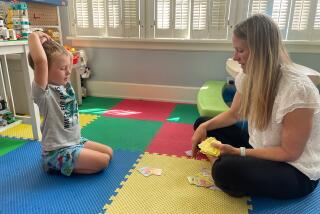Sometimes Distance Brings Us Together
- Share via
In the middle of an important business call, your child relentlessly demands your attention.
Or, you say you can’t take her to the mall and she says she hates you and wishes you were dead.
Or, he has dyed his hair platinum and is beginning to talk like a Nazi.
You could count to 10 (or 1,000). You could walk around the block for a few days. You could also, of course, spank, threaten, cry or argue.
Or you could simply pretend that this isn’t your child at all, that this is, say, the neighbor’s child.
When a child’s behavior threatens to hook parents into a power struggle, disengagement techniques, known as cognitive restructuring, are ways to achieve some distance and buy time to avoid saying or doing something parents will regret later.
“It’s all about keeping your cool,” said Marlyn Osborn, a therapist at the Newport Beach Center for Cognitive Therapy. “If you get angry, you’ve been trapped into that power struggle. When you keep your cool, you have so many more options in terms of handling things.”
Commonly, parents need to disengage from faulty beliefs that their child’s behavior determines their value as parents or human beings, she said. Add to that the multiple responsibilities and precariously balanced schedules of today’s parents and you have little room for kids to grow up through normal trial and error.
Mentally picturing your children as someone else’s makes kids appear to be what they actually are in reality--separate people, Osborn said. Then, their behavior telegraphs more about themselves as children learning to grow up than about the parents as failed teachers or models.
Some parents whose teenagers do things that embarrass them, such as body piercing or hair dying, can also ask themselves, “Will I care in 10 years?” Then, they can get on a more positive track by asking, “What is right with this child?”
Parents of teenagers who are acting out in wilder ways can also calm themselves by trying to remember how tiny, sweet and innocent their children once looked as they slept in their cribs.
“What disengagement does is remove the immediate feeling of crisis and add some distance and room to maneuver,” Osborn said. “When you gain that distance, it’s hard for them to push your buttons.”
Distancing also helps parents perceive shades of gray in typically black-and-white thinking about their children. Osborn said parents tend to think: “Either the child behaves perfectly, or they’re going to become juvenile delinquents and end up dead in an abandoned house. Either they follow everything to the letter or I have lost total control and will never be able to regain control.”
A mother who breaks down sobbing when her child says hateful things can learn that he is just angry and will continue to love her in the future, Osborn said. A father who becomes enraged when his child espouses a political or religious doctrine he can’t abide can learn to ask questions. Perhaps the child has picked up the beliefs of a charismatic friend.
The wife and children of a high-level executive, who expected perfection of them, had become afraid of his violent reactions, the wife said. When she threatened to leave, he sought counseling and learned to calm down. First, he disengaged by walking out of a room, counting to 10 and breathing deeply. Then he began asking, “In 10 years would I care?” and “If things were not perfect, what’s the worst that could happen?”
He educated himself about child development and what children can realistically be expected to do at certain ages. Now, his wife said, “He’s scaling back his expectations, is more understanding and less demanding. Now, he’s working on being forgiving of himself.”
If they can remove themselves from the fray, parents can look at the evidence to see whether or not anyone has failed. In most cases, neither the parents nor the children are perfect, she said, but neither are they failures.
* Lynn Smith’s column appears on Sundays. Readers may write to her at the Los Angeles Times, Life & Style, Times Mirror Square, Los Angeles, CA 90053 or via e-mail at lynn.smith@latimes.com. Please include a telephone number.
More to Read
Sign up for Essential California
The most important California stories and recommendations in your inbox every morning.
You may occasionally receive promotional content from the Los Angeles Times.













